and the liberating essence of alchemy
Photographs and totemic sculptures merge in Gøneja ✷’s most recent solo show Mercurial, presented at the Organ Kritischer Kunst gallery in Berlin. The secretive, ancient practice of alchemy is subtly revealing itself through each piece, emerging as a contemporary interpretation of the hermetic principle As Above, So Below. Alchemy is the process of purification, freeing oneself from the limitations of a certain physical state, healing, becoming whole.
Gøneja ✷’s portraits alternate between an arcane, yet playful intimacy and an enigmatic distance. Every subject emanates the transcendence of duality, moving fluidly through the ethereal and physical realms, becoming a hologram of the liberated mind. Portraying individuals who have released themselves from the identification of gender binaries or common social classifications is an act of amplifying the collective churning towards healing. In contrast with the abstract nature of the photographs, the Berlin-based artist presents physical totems built by cutting and assembling left-overs of metal pieces and up-cycled materials, evolving them into purer forms. Through exploring the archetypes of nature and society, the landscapes bare the beauty of brutalism juxtaposed with eerie, natural settings. He unveils the concrete architecture of past-time social regimes forgotten at the edges of modern society, with the hope to erode and transmute them. As Jung says, people go into war because they have not resolved their inner battles.
So what are our tools to conceal the inner emptiness and integrate the known and the unknown, to become exalted? In the following interview, we investigate the creative process of individuation and the artist’s role as a catalyst for change. True alchemical work is to incarnate the divinity inside us, to bring its presence into our bodies, into our minds and onto the world. This is the activism we should all take part in—becoming whole. In his works, Gøneja ✷ captures precisely this unity – the liberating essence of alchemy.

Mercurial and your work in general stands out with distinctive portraits. What made you approach these identities and how do they inform your work and your message as an artist?
One of my attempts with Mercurial was to choose a range of subjects with an idiosyncratic character and to create portraiture that would interpret the alchemical theme in profoundly individual ways. With each portrait, the approach I employed has been shaped and developed around my understanding of each subject, as I know all of them personally.
With Métaraph, for instance, we wanted to emphasise their distinctively fluid artistic identity through the use of make-up and clothing, which are elements that feature strongly in their DJ-sets and performances.
By combining various unique perspectives in a single series, I’m also hoping to bring an overall sense of diversity, which is a message I consciously wish to convey with my work.
Do you intend to expose being gender-fluid, trans and non-binary in Mercurial as a statement?
Indeed, a large number of the subjects portrayed identify as trans or/and non-binary, and I believe all of them identify as queer. The overall fluidity that informed the gender perspective of this whole series occurred rather spontaneously.
In retrospect, however, it had resonance as the mercurial mind thinks and moves beyond polarities, including those of binary gender classification.
The only time that I deliberately focused on gender identity, or more accurately on gender transition, was with the nudes I made with Gia. We thought that her naked body, with the signs of the hormone replacement therapy, carried its own story of alchemical transformation, thus we completely abstracted the context, and photographed instead in a neutral, white studio.
Gia is also advocating for Body Positivity, hence it made it easier to portray the idea through nudity.
Gøneja, portrait by Ema Discordant
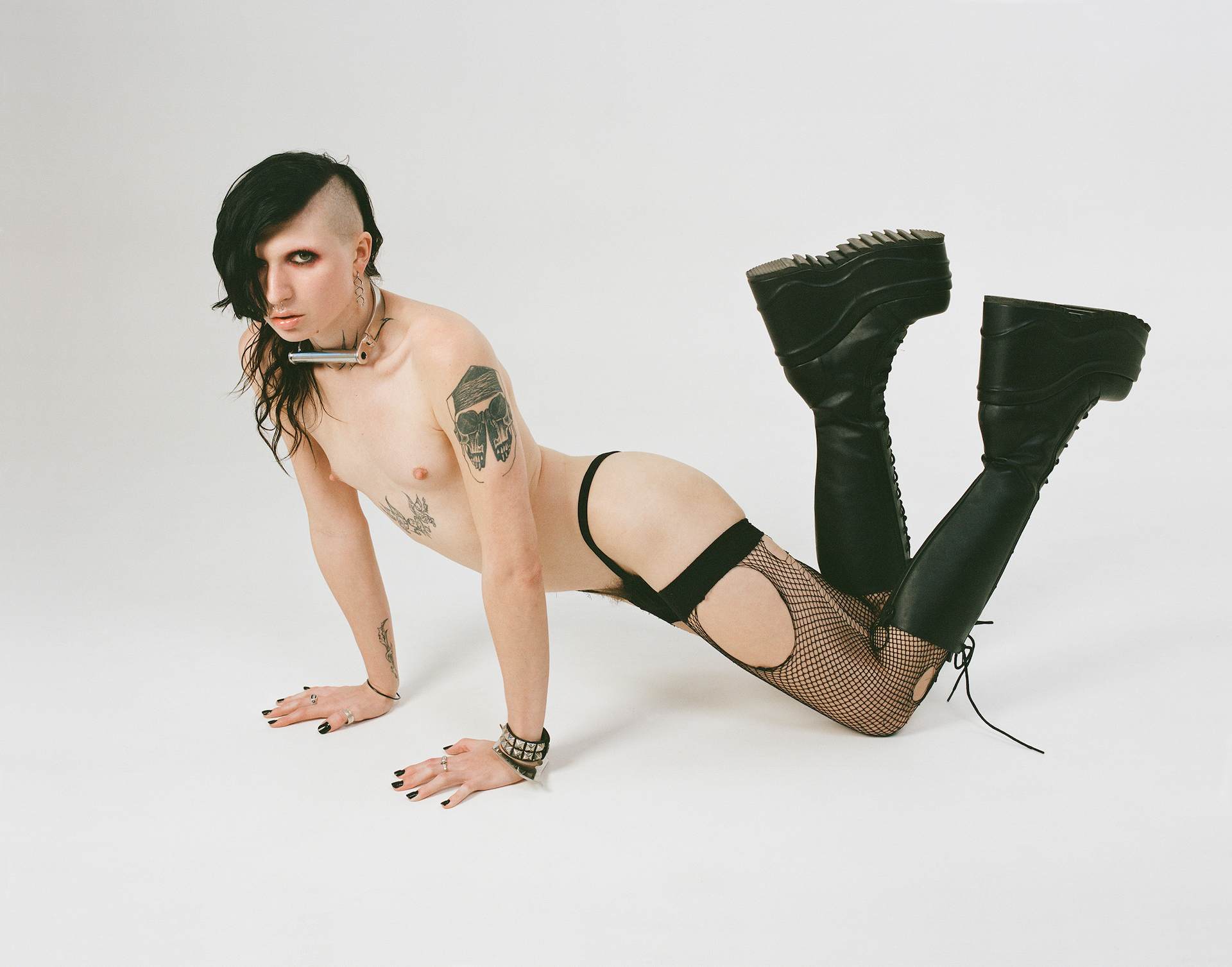


How has disseminating this message helped you evolve in your work as an artist? Tell us about the context of this exhibition as a continuation from your previous opus Rituals?
Mercurial is a natural evolution of Rituals whereby it explores spiritually-charged territories, while this time I felt more determined to advance in this direction as the main drive of this work and my overall artistic practice. But while in Rituals, the main idea was intertwined with the medium, in Mercurial, it set itself with more autonomy, and the media came in its service.
More specifically, in Rituals, the act of photographing expressed the very rituality of the work, while in Mercurial, the alchemical theme at times decided its own way of expression, leaving space for unexpected results. To make an example, in the portraits I made with Marat and Ester my starting idea was to focus on the intimate bond of their souls as a peculiar alchemical synergy.
While photographing, however, the Pietà, a famous motif of Christian iconography, suddenly appeared, charging the work with a deeper symbolic meaning and influencing the later development of this series.

What place does alchemy find in contemporary society? How did it find its way into your work?
My journey with alchemy started by taking up a Center for Applied Jungian Studies course in 2018, and realising its enormous transformative and curative potentials.
Jung believed that alchemical work was a metaphor for the inner quest of spiritual unfolding and that alchemical knowledge could offer a pathway to the unconscious.
Personally, towards the end of the course, I was able to unearth a remote childhood trauma resulting as one of the most healing experiences of my life.
As some time after that episode passed, and a new artistic series was about to begin, I felt ready to explore this territory with my work. The medium of photography felt in line with the alchemical practice, as the analogue techniques which I predominantly use imprint light on film by means of chemical reactions. The metalworking techniques too, used for the construction of the sculptures, also spoke about the alchemical activity of transmuting and redefining base metals.

As per what relevance could this practice have in contemporary society is a rather big question. Historically, we are living in very urgent times. Our technologically developed global civilization keeps facing constant new challenges, which we seem unable to resolve.
The unsettling geopolitical climate producing humanitarian crises affecting millions on this planet, and the heavily polluted natural world rapidly pushed beyond its ability to sustain life are only two examples. As Terence McKenna would put it, on the one hand, we possess the resources and technologies to be able to resolve our problems, but on the other, we lack the intellectual vision and moral strength to make those changes.
The problems we face reflect a rather inner crisis of mankind, highly connected to others and to the world by means of technology, but profoundly isolated and spiritually-paralysed in a deeply materialistic and individualistic society, raging towards self-annihilation.

To the contrary, alchemists believed that the redemption of this world had to be achieved spiritually, through radically pushing human consciousness forward.
What alchemy can offer, in my experience, is the expansion of the human mind towards fundamentally different ways of being and acting in the world, connected to the mysticism of existence, the sacrality of life and the harmony of creation.
In these challenging global times I believe that the solutions to our problems have to be looked for within, and here is where alchemical knowledge could come to our help and where it would, now as ever, fulfil its ultimate spiritual purpose.

What are your thoughts on documenting alchemical processes, magic and art as a form of rebellion and using higher knowledge to transcend above the constructs of rationality?
I do believe that reason alone is limiting and that a type of knowledge which is drawn purely by rationality won’t be able to provide appropriate answers to the complexity and scale of our urgent global problems.
Contrariwise, the alchemical thinking reaches beyond rational restrains towards a more holistic vision of the world, seeking answers rather intuitively, mystically or by means of magic.
One work from Mercurial which, to me, epitomises how the mercurial mind can act as a form of resistance against the tyranny of rationality, is the nude portraits I made with Berenice. There is a certain honest ambiguity to this image, which still retains its identity rather softly. Perhaps it is the mysterious combination of an undefinable body posture and the intimate presence of the gaze, that to me expresses a higher level of complexity.
You can’t put it into words but you can perceive that this image captures an intuitive, rather than rational, way of thinking and feeling.

Your photos depict either people or objects in remote spaces – is this also a reflection of those identities being outcasted from normative social structures?
Indeed with this series, I kept a clear continuity between all the compositions by placing unusual or striking subjects inside distinctively solitary, empty physical contexts. While this process was informed by aesthetic, rather than political, decisions, this latter interpretation can also be true.
In my experience, a truly authentic path of individuation comes with a lot of inner work and struggles, which not every person is ready to commit to.
Those who do however, by pursuing their uniqueness in the world, also manage to shake conservative social structures and challenge the views of normative and conformist societies. While defending your uniqueness in this world can be a hard process, I do believe that there is a lot of beauty to be found in that journey, hence why, compositionally, the images might follow those aesthetic lines.
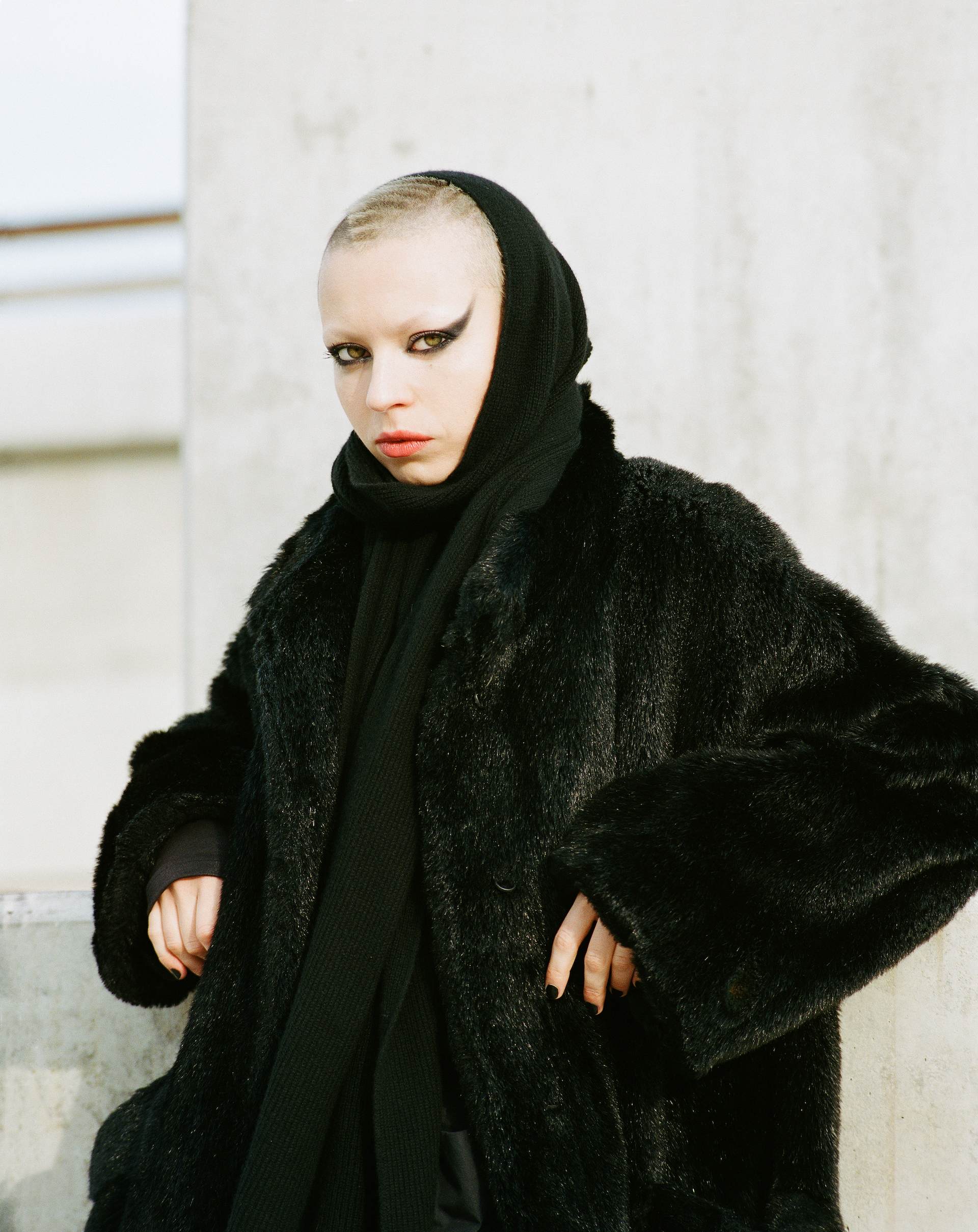
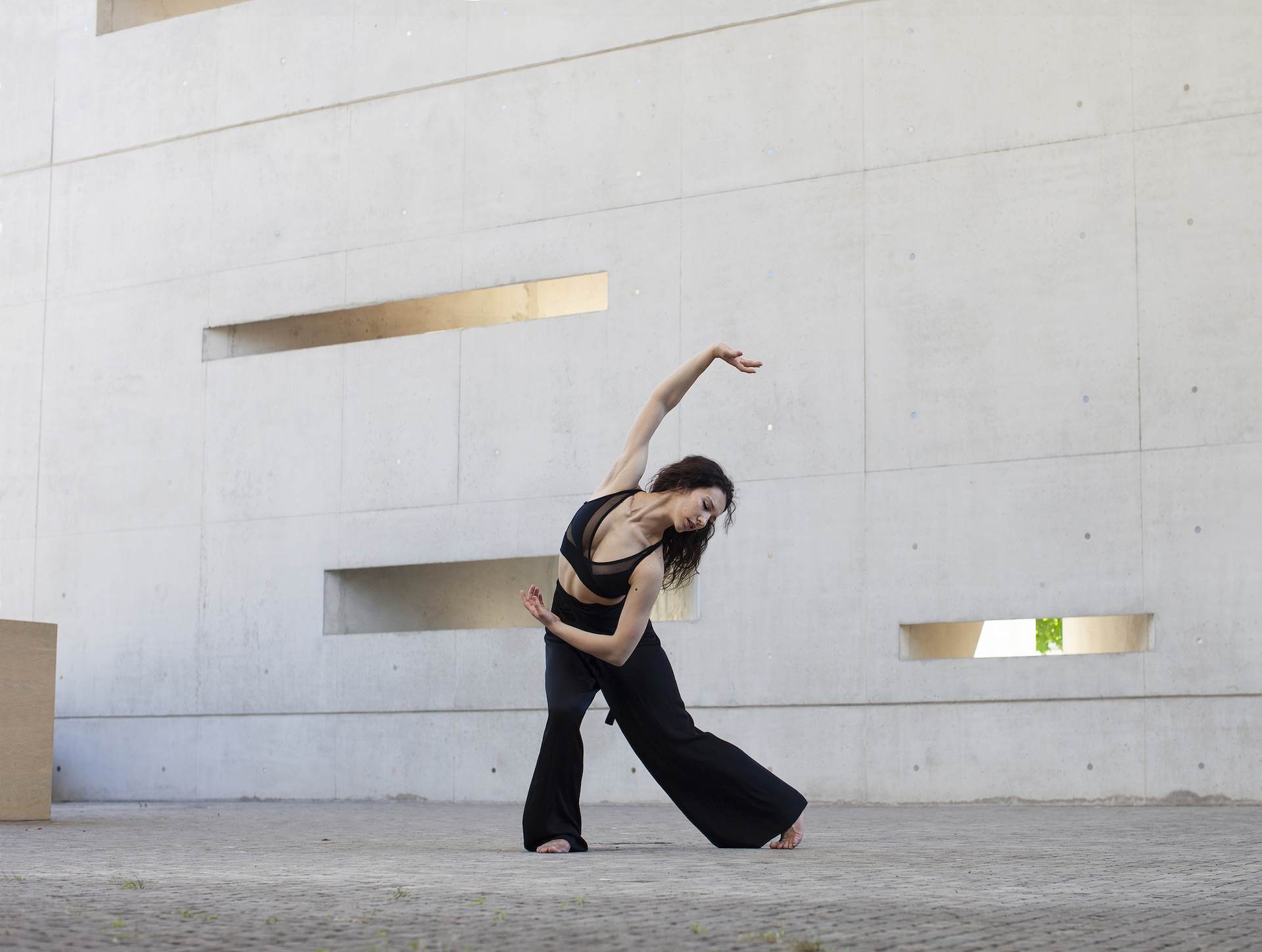
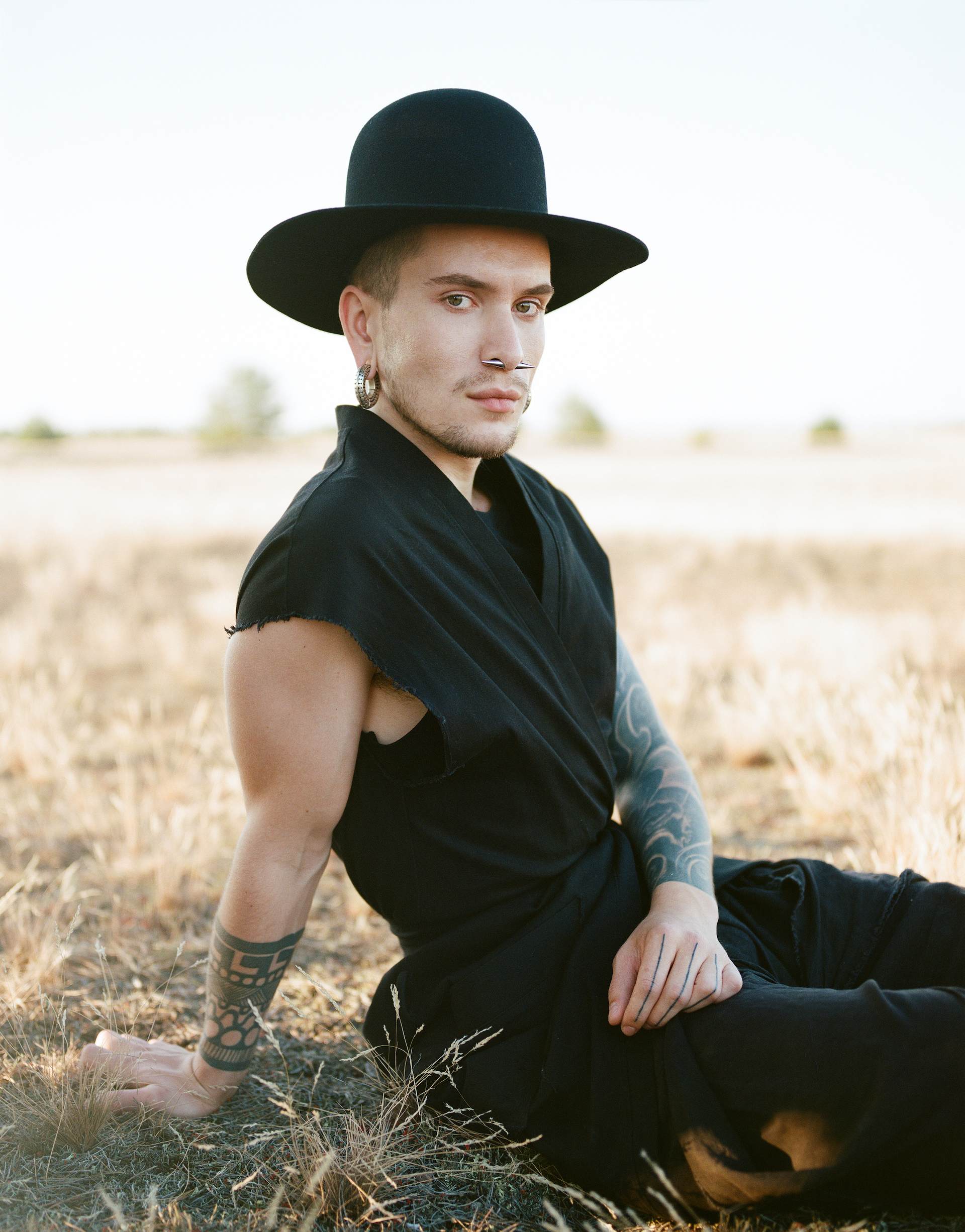
You juxtapose brutalist architecture and monuments with pristine natural landscapes. What does this contrast express in your photos?
In this portfolio, from a photographic perspective, I wanted to work with the mercurial paradox of creating fluid sculptures. On the one hand, the portraits depict living bodies which are rendered sculptural by the postured physical positions and the symbolic motifs which they often represent. While, on the other hand, the landscapes – depicting a neglected World War II bunker turned up-side down and a colossal abstractly-designed war memorial – are rendered fluid by the natural environment.
Both heavy concrete structures, in fact, sit alone in landscapes which are informed by water: with the evening high tide of a beach in Normandy in the first case, and the snowy peaks of the Bosnian mountains in the second.
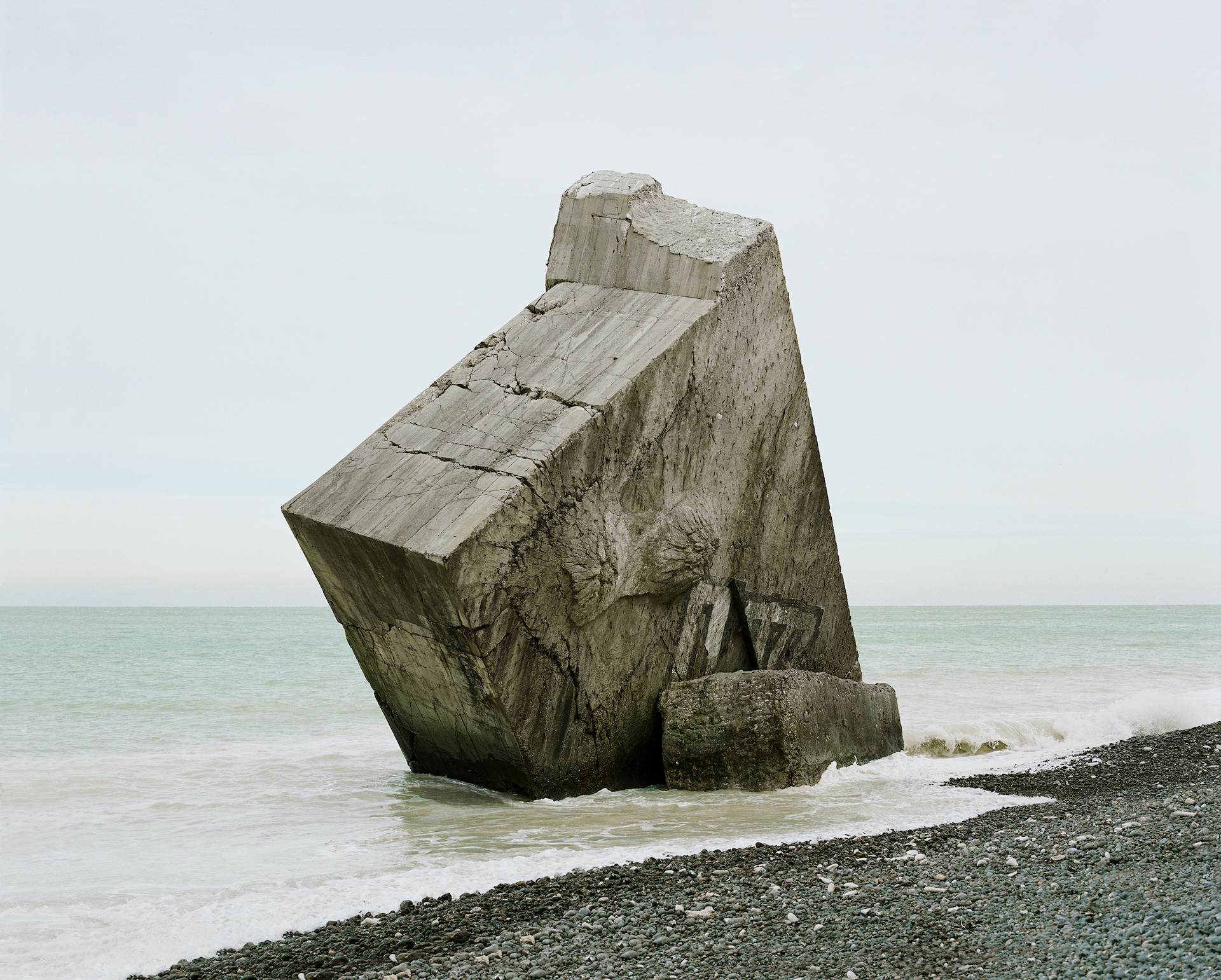
Do you feel drawn to capture the essence of your subjects in spiritual and symbolic spaces and locations? Does it contribute to the dynamic of the photographing as well?
Indeed, locations play a big role in my photography. I photograph quite exclusively in empty spaces to leave more emphasis on the subjects, while contextualising them within a certain environment – be it domestic, urban or natural.
When it comes to architecture, there is a specific type of locations I like; mostly minimalistic or industrial spaces with a ritualistic feel. To some degree, these rather austere locations do allow for a certain sacrality of the space to be created, and add a level of ceremoniality to the act of photographing.
A clear example from Mercurial are the performative portraits of the dancer Tsuki. Her name is the Japanese word for Moon, as her artistic and teaching practice incorporates the cyclicality of the lunar knowledge and the mysticism associated with night-time. The location in which we shot, to the contrary, resembles the Sun, with a clear solar motif embedded within a mysterious industrial architecture.
Tsuki’s dance, soft and open, in such a space, heavy and dark, helped to create a truly alchemical image; one that combined and harmonised the lunar and solar opposite polarities, creating a very unique mercurial dynamism.

Three of your pieces embody astrological archetypes. How did those motifs appear and do they hold a specific place within the whole work?
Placing both Scorpio and Taurus in this series was deliberate. Alchemists, in fact, observed and studied the night sky tirelessly, tuning in the ancient wisdom associated with the planetary alignments, the Sun entering the twelve Zodiacal constellations, and the infinite motions of the cosmos.
With both subjects I wanted to create a specific astrological narrative which was somewhat relevant to the constellation it portrayed.
More specifically, with Agata we achieved the back-bended posture through the use of shibari, a Japanese bondage practice, which ultimately emphasised the sexual nature of Scorpio; a constellation associated with the dark areas of the human psyches surfacing with the peak of Autumn and the surrounding death of the natural world.
While the heavy steel piece that constructed the Taurus totem, speaks rather about the earthly, terrestrial qualities of this sign, which has its season during the mid-Spring harvest.
When it comes to the Sagittarius, the decision to include it in this series was unintentional, as the archetype manifested unexpectedly. Leonardo and I decided to set the portraits in a lake during a late, summer afternoon, as the metallic look of the waters had a truly alchemical glow.
Yet, through the arching of his arm, given by a classical dance movement, and the shadow of the upper body reflecting on the surface of the lake, the mythological centaur favourably made itself visible in the photograph.
Agata: Scorpio,(2021), Agata embodying her own Zodiacal sign through a shibari suspension and a visionary nail design
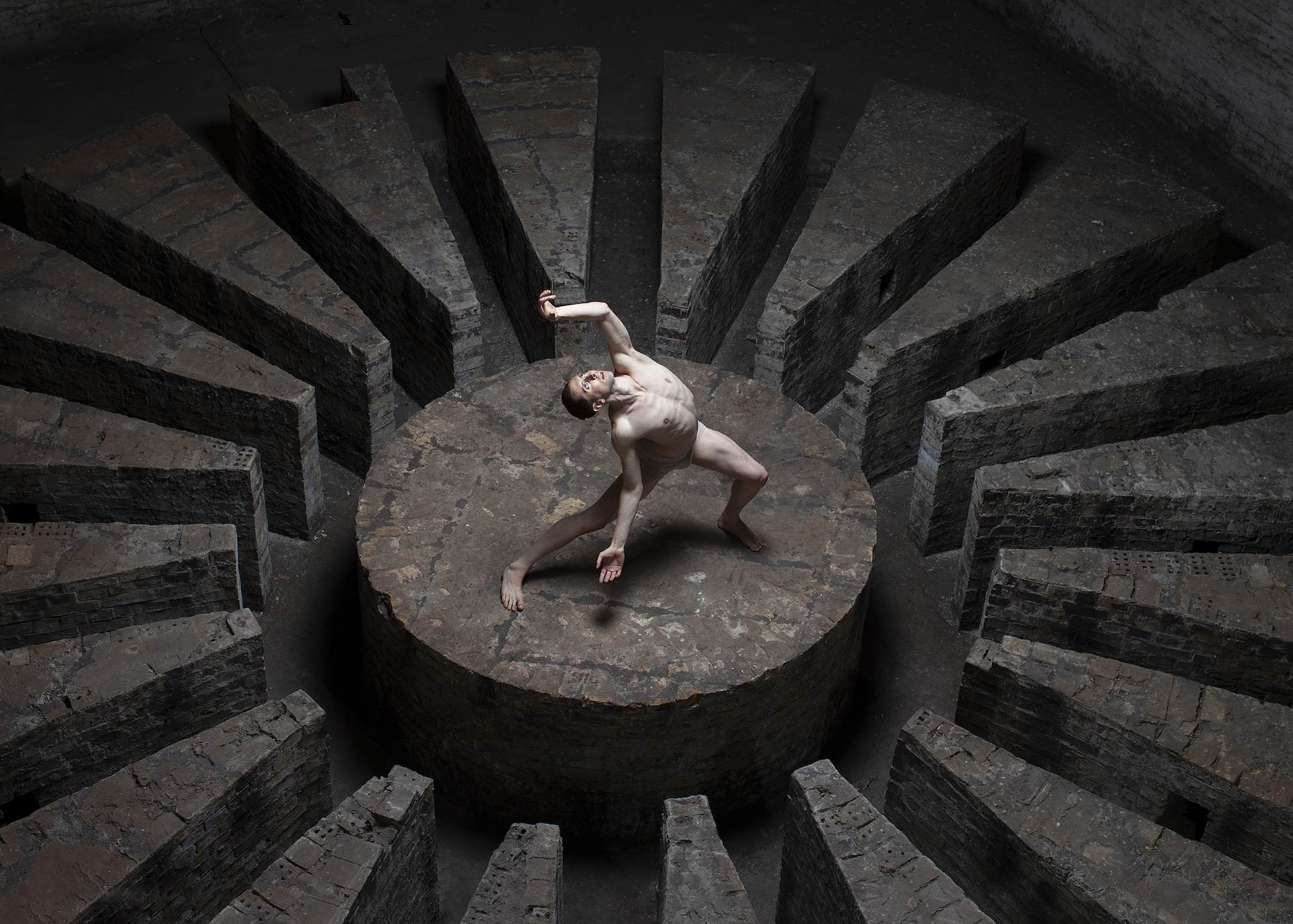

For this exhibition you also created sculptures. How do they complete this work? What was special in your process of making something physical?
Creating sculpture for this series started from a genuine desire to expand beyond photography and to set the steps of finding my artistic voice without being bound to a single medium. On the one hand, the sculptures in this series demanded their own identity, but on the other, somehow they also completed the photographs.
People confuse photography for reality and I believe that having the sculptures in the exhibition helped them to look at the photographs more abstractly, focusing rather on the motifs, compositions and symbolism and understanding them as artistic representations.
In terms of process, I decided to work exclusively with metals, which turned out to be a truly alchemical experience.
There is a certain magic in the manipulation of these materials which you can only grasp in the workshop as metals are cut or melted in the welding process, filling the room with sparkles resembling some real alchemical laboratory experimentations.
I also very much enjoyed working exclusively with up-cycled materials and left-over pieces, as it made the whole sculptural process more unpredictable and open to the gifts of chance.
Spirit Monad, (2021),Totemic adaptation of an ancient esoteric symbol made with discharged automobile brakes and steel tubes, Cast iron & steel
The Hieroglyphic Monad is used as a central symbol for this exhibit. Tell us more about its significance and how it fits with the ideas you explore throughout Mercurial?
For each series I work on I always find a symbol that reconciles the main ideas and which becomes a guide for the entire work.
For Mercurial it was the Hieroglyphic Monad, an esoteric emblem created by the 16th century British alchemist John Dee, who was the court’s astronomer and advisor of Queen Elisabeth I.
It’s constructed by various symbols combined: the Sun and the Moon, at the top, the Earth, represented by the cross of the four elements, in the middle, and the constellation of Aries, as the beginning of the Zodiacal circle, at the bottom. It also inscribes within itself the symbols of Mercury, Venus, Mars, Jupiter and Saturn, which were the other known planets in Renaissance cosmology. It’s a powerful hieroglyph which epitomises Dee’s belief of the unity of the cosmos and was at the base of all his astronomical studies.
Personally, the Monad appeared early on in my research and immediately caught my attention; I instantly recognised it as the symbol destined to guide me throughout this work.
In retrospect, I clearly see its resonance with my ambitions behind this series, very much fitting in the cosmic perspective explored with the planetary and astrological themes as well as the overall symbolic thinking.
I was also able to recreate the motif as a sculptural object using discharged automobile brakes and some steel off-cuts used mostly in interior design construction.
Follow Gøneja*on Instagram
Author/Contributor: Lora Mateeva
